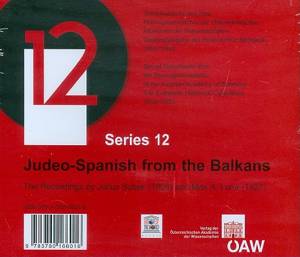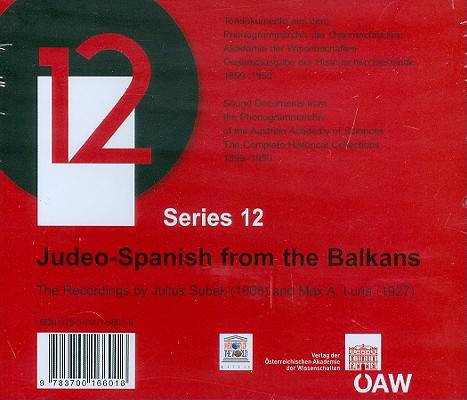
- Afhalen na 1 uur in een winkel met voorraad
- Gratis thuislevering in België vanaf € 30
- Ruim aanbod met 7 miljoen producten
- Afhalen na 1 uur in een winkel met voorraad
- Gratis thuislevering in België vanaf € 30
- Ruim aanbod met 7 miljoen producten
Zoeken
Judeo-Spanish from the Balkans LUISTERBOEK
The Recordings by Julius Subak (1908) and Max A. Luria (1927)
Christian Liebl
CD | Engels
€ 56,45
+ 112 punten
Omschrijving
During 1908/1909, Julius Subak (1872-1936), an Austrian Romance scholar, was entrusted by the Balkans Commission of the Imperial Academy of Sciences to record, both in writing and phonographically, the Judeo-Spanish of the Balkan Peninsula. He conducted his primarily linguistic investigation among the descendants of those Sephardim who - expelled from Spain in 1492 - had sought refuge in the Balkans, then part of the Ottoman Empire. The resulting 15 Phonogramme are said to be the first recordings of Judeo-Spanish (or Ladino) made for scholarly purposes. They contain chiefly poems and romances (the orally transmitted ballads from medieval Spain), but also songs and a passionate appeal to preserve the Judeo-Spanish language. Subak even succeeded in recording prominent representatives of Sarajevo's Sephardic community - such as Abraham A. Cappon, who is reciting from his own works. In 1927, the US-American Max A. Luria (1891-1966) undertook linguistic field research in Monastir (present-day Bitola, FYROM) as part of his doctoral dissertation. Equipped with an Archivphonograph, he made a total of 26 recordings which - featuring proverbs and dialogues, but above all numerous konsezas (folktales) - bring to life again this particularly conservative dialect of Judeo-Spanish. The contributions by Aldina Quintana Rodriguez, Edwin Seroussi and Rivka Havassy as well as Paloma Diaz-Mas highlight the importance of these unique sound documents, especially for Judeo-Spanish dialectology, but also for the study of Sephardic music and literature. Together with the transcriptions, they constitute a valuable supplement to the recorded witnesses of a once flourishing culture on the eve of cataclysmic changes.
Specificaties
Betrokkenen
- Auteur(s):
- Uitgeverij:
Inhoud
- Aantal bladzijden:
- 77
- Taal:
- Engels
Eigenschappen
- Productcode (EAN):
- 9783700166016
- Verschijningsdatum:
- 1/12/2009
- Uitvoering:
- CD
- Formaat:
- CD standaard audioformaat
- Gewicht:
- 198 g

Alleen bij Standaard Boekhandel
+ 112 punten op je klantenkaart van Standaard Boekhandel
Beoordelingen
We publiceren alleen reviews die voldoen aan de voorwaarden voor reviews. Bekijk onze voorwaarden voor reviews.











